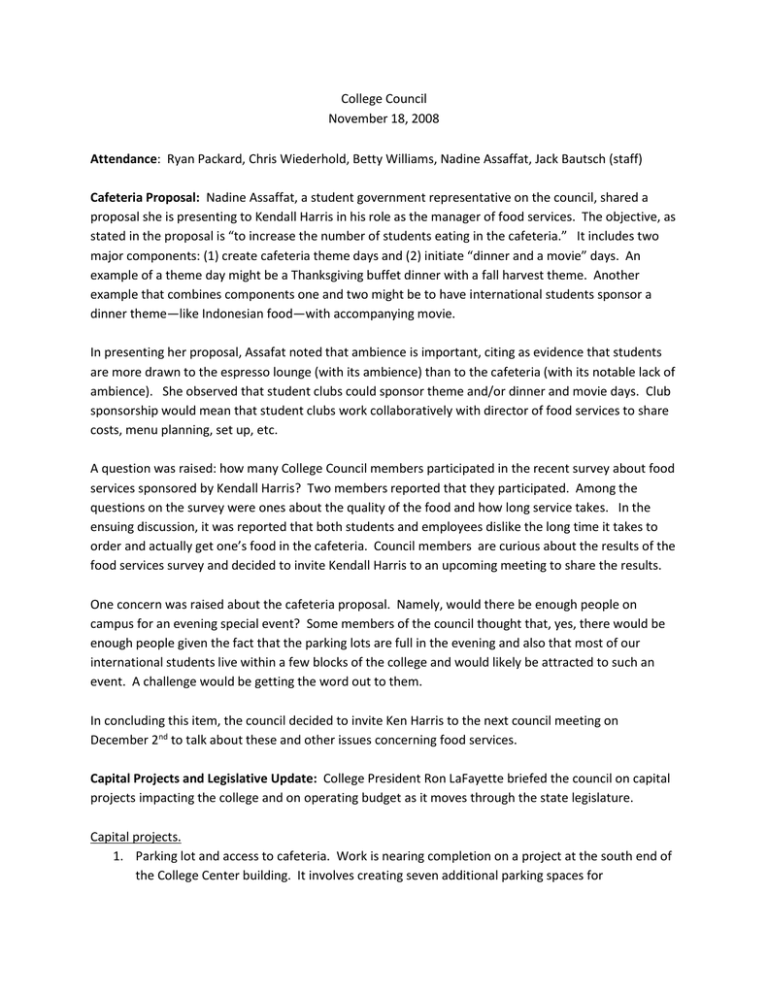College Council November 18, 2008
advertisement

College Council November 18, 2008 Attendance: Ryan Packard, Chris Wiederhold, Betty Williams, Nadine Assaffat, Jack Bautsch (staff) Cafeteria Proposal: Nadine Assaffat, a student government representative on the council, shared a proposal she is presenting to Kendall Harris in his role as the manager of food services. The objective, as stated in the proposal is “to increase the number of students eating in the cafeteria.” It includes two major components: (1) create cafeteria theme days and (2) initiate “dinner and a movie” days. An example of a theme day might be a Thanksgiving buffet dinner with a fall harvest theme. Another example that combines components one and two might be to have international students sponsor a dinner theme—like Indonesian food—with accompanying movie. In presenting her proposal, Assafat noted that ambience is important, citing as evidence that students are more drawn to the espresso lounge (with its ambience) than to the cafeteria (with its notable lack of ambience). She observed that student clubs could sponsor theme and/or dinner and movie days. Club sponsorship would mean that student clubs work collaboratively with director of food services to share costs, menu planning, set up, etc. A question was raised: how many College Council members participated in the recent survey about food services sponsored by Kendall Harris? Two members reported that they participated. Among the questions on the survey were ones about the quality of the food and how long service takes. In the ensuing discussion, it was reported that both students and employees dislike the long time it takes to order and actually get one’s food in the cafeteria. Council members are curious about the results of the food services survey and decided to invite Kendall Harris to an upcoming meeting to share the results. One concern was raised about the cafeteria proposal. Namely, would there be enough people on campus for an evening special event? Some members of the council thought that, yes, there would be enough people given the fact that the parking lots are full in the evening and also that most of our international students live within a few blocks of the college and would likely be attracted to such an event. A challenge would be getting the word out to them. In concluding this item, the council decided to invite Ken Harris to the next council meeting on December 2nd to talk about these and other issues concerning food services. Capital Projects and Legislative Update: College President Ron LaFayette briefed the council on capital projects impacting the college and on operating budget as it moves through the state legislature. Capital projects. 1. Parking lot and access to cafeteria. Work is nearing completion on a project at the south end of the College Center building. It involves creating seven additional parking spaces for Employment Security (ES) clients per an agreement between the college and ES. It also involves creating a new area for food services deliveries. This work represents a completion of the renovation done to accommodate Employment Security’s move to campus. This work was paid for by Employment Security. 2. Repair and Minor Improvements. The college receives an allocation for these types of capital projects. A campus committee manages this money and projects. No further details were provided about any such projects either in-progress or pending. 3. Major projects. The college is working on three major construction projects. Each is at a different stage. a. Remodel of the technology building. This project was rated #1 by the statewide group who reviewed requests for major projects within community and technical colleges. It involves a complete remodel of the first floor of the technology building, creating a second floor on the building, and making seismic improvements. Program space within the building will be modified according to faculty and staff needs/desires as identified through the design process. If all goes as planned, construction would begin in Fall 2011. b. Integrated Resource Center. This project has been in the planning stages for a couple of years. It would involve location Employment Security and some DSHS services in the first and second floors of the south end of the technology building. It represents a partnership among ES, DSHS and NSCC to work collaboratively to serve the clients who come for services that intersect/overlap. The goal is to provide more efficient and effective and comprehensive services in a “one stop” center. Funding for this project does not come through the regular channels, but through a special allocation by the state legislature. At present, the project is about $13 million short of what is needed. The president reported that funding may be included in the governor’s economic stimulus package. There are some who advocate getting started earlier than scheduled on this project (along with other construction and infrastructure projects) in order to get economy moving and people to work. President LaFayette also noted that capital funding comes from a very different source (bonds) than the operating budget (taxes and fees into the state general fund). c. Student Center. Currently there is no money for this project. It is simply on the college’s “wish list.” The concept is to make the courtyard the center of campus by creating a student center between the arts and sciences and technology buildings by enclosing that space. The intent is to create a place of warmth and communityconvening similar to the “quad” at the University of Washington. Current thinking is that such a project could be possible by raising money through student government and the college foundation and then accessing up to $2.0 million in matching funds available from the state for such projects. 4. CTC Operating Budget. This story changes regularly as economic news changes. For the 200911 biennium, the state is currently anticipating a $5 billion budget deficit at current spending levels. The state board ( SBCTC ) has asked the colleges to devise plans for a 10% reduction effective July 1, 2009. This does not mean we will actually get a 10% reduction, but we need to plan for it in case we do. For NSCC, a 10% reduction would mean about $1.6 million. Agencies that report directly to governor have been asked to consider a 20% reduction. Whatever the size of the reduction, an increase in student tuition (of some unknown magnitude) is likely. On November 19 a new revenue forecast is coming out, and the picture may change at that point. The college has already taken a cut of about $500,000 for the current biennium (ending June 30, 2009). The November 19 forecast might increase the amount we have to cut for this biennium. As they are developed, budget reduction proposals will be brought to the council to consideration and discussion. After the president left, the council talked about student financial aid. Members were not certain which loan programs the college offered, what portion of financial aid was given in the form of grants, loans, scholarships and work-study, etc. At some future date the council may invite Suzanne Scheldt, Director of Financial Aid, to discuss these issues with the council. Adjournment: The meeting adjourned at 4:09. Minutes taken by Jack Bautsch


